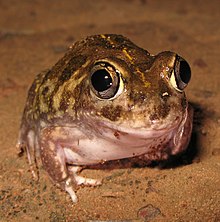Sudell's frog
| Sudell's frog | |
|---|---|

| |
| Scientific classification | |
| Domain: | Eukaryota |
| Kingdom: | Animalia |
| Phylum: | Chordata |
| Class: | Amphibia |
| Order: | Anura |
| Family: | Limnodynastidae |
| Genus: | Neobatrachus |
| Species: | N. sudellae
|
| Binomial name | |
| Neobatrachus sudellae (Lamb, 1911)[1]
| |

| |
| Range of the Sudell's frog | |
| Synonyms[2] | |
|
Heleioporus sudelli Lamb, 1911 | |

The Sudell's frog, painted burrowing frog (Neobatrachus sudellae), trilling frog or desert trilling frog (formerly Neobatrachus centralis) is a species of burrowing frog common to a large part of southeastern Australia. It is found on and west of the
Taxonomy
First described in 1911 by Joseph Lamb (born 1869), the author assigning the name Heleioporus sudelli. The specific epithet honours "Miss J. Sudell", who collected the type specimen near Warwick in Queensland.[2][1] It was transferred to the genus, Neobatrachus, to become Neobatrachus sudellae in 2012, the epithet reflecting the gender of its namesake.[4]
The decision that is the same species as Neobatrachus centralis is based on work by Roberts in 2010.[2][5]
Description

The Sudell's frog is relatively small, reaching only 40 mm in length. It is highly variable and is generally brown, however it may also be grey, yellow or reddish on the dorsal surface with irregular darker spots or blotches. There is often a pale mid-dorsal stripe running down the back. The belly is smooth and pale cream or white. The toes are fully webbed, however a deep indentation is present between the webbing of each toe. The metatarsal tubercles (a shovel like structure on the foot to assist with burrowing) are completely black. The pupil is vertical and iris is silver.
The trilling frog is a medium-sized short, fat frog (5 centimetres measured from
Distribution
The trilling frog is found throughout the central Australian deserts in a band encompassing
Ecology and behaviour
Sudell's frog inhabits ponds, dams, ditches, clay pans or any still water in woodland, shrubland, and disturbed areas (including farmland). Males make a short trilling sound while floating in water after heavy rains, which flood the breeding area, from late winter through to autumn. The species is an adapted burrower and will often spend periods of time underground to avoid drought conditions.
About 600 eggs are laid in a clump entwined among vegetation near the surface, however will sink if disturbed. Hatching occurs about 3 days after laying and tadpoles are plump and large reaching about 77 mm (at about stage 40). The tadpoles often overwinter and metamorphs measure from about 20 to 30mm in length.
The trilling frog is adapted to desert conditions and can spend years without having to surface, buried deep underground with their
They eat the numerous insects accompanying the rains and lay eggs in drawn out clumps, often wrapped around snags in the water. The tadpoles mature very quickly.
Like most Australian frogs, the trilling frog is an opportunistic
Similar species
It is similar to other species of
Genetics
This interesting little frog is a
As a pet
It is kept as a pet.[7] In Australia this animal may be kept in captivity with the appropriate permit.
References
- ^ a b Lamb, J. (1911). "Description of three new batrachians from southern Queensland". Annals of the Queensland Museum. 10: 26–28.
- ^ a b c "Species Neobatrachus sudellae (Lamb, 1911)". Australian Faunal Directory.
- ^ "Ilparpa Claypans". ausemade.com.au. Retrieved 10 April 2023.
- ^ Shea, Glenn (2012). "Emendation of the specific name of the frog Neobatrachus sudelli (Lamb, 1911) (Anura: Myobatrachidae)" (PDF). Memoirs of the Queensland Museum – Nature. 56 (1).
- Wikidata Q99953024.
- ^ DEH, Trilling Frog Call
- ISBN 0-9758200-0-1
Bibliography
- Anstis, M. 2002. Tadpoles of South-eastern Australia. Reed New Holland: Sydney. ISBN 1-876334-63-0
- Robinson, M. 2002. A Field Guide to Frogs of Australia. Australian Museum/Reed New Holland: Sydney. ISBN 1-876334-83-5
- Jean-Marc Hero, Dale Roberts (2004). "Neobatrachus centralis". . Retrieved 12 November 2021. Database entry includes a range map and justification for why this species is of least concern
- Cogger, H.G. 1979. Reptiles & Amphibians of Australia. A. H. & A. W. REED PTY LTD. ISBN 0-589-50108-9
- Mahony MJ, Robinson ES. Polyploidy in the Australian leptodactylid frog genus Neobatrachus.. 1: Chromosoma. 1980;81(2):199-212.
- J. L. Read, Abundance and recruitment patterns of the trilling frog (Neobatrachus centralis) in the Australian arid zone. Australian Journal of Zoology 47(4) 393 - 404
- Tyler, M.J. 1994. Australian Frogs A Natural History. Reed Books ISBN 0-7301-0468-0
- Anstis, M. 2002. Tadpoles of South-eastern Australia. Reed New Holland: Sydney.
- DEH Frogs of SA > Neobatrachus centralis

